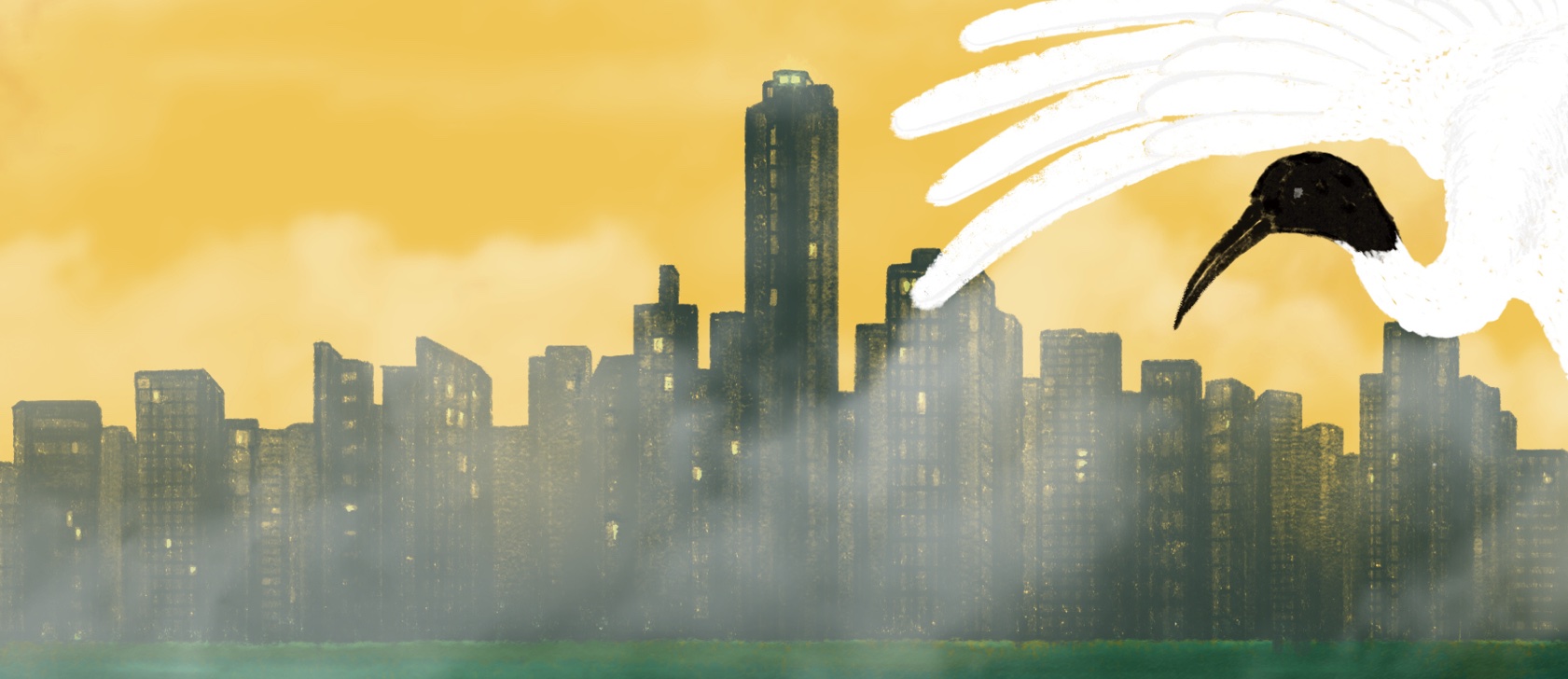In Téa Obreht’s dystopian future, the lights are still on. Cell phones work, online forums breed new conspiracy theories, and the government functions—at least enough to distribute rations of “canned gruel.”
Set in a future of forest fires and submerged cities (the year is unspecified, but eating meat is considered a barbarism of the distant past), Obreht’s third novel, The Morningside, is the author’s first foray into climate fiction. Instead of depicting a world blown apart instantly by an asteroid or pandemic, Obreht imagines what might happen if the crises of our own era—rising temperatures, mass displacement, stark wealth inequality—continue unchecked.
The novel’s heroine, 11-year-old Silvia, has spent her entire life in transit. She barely remembers the homeland, a country destroyed by mudslides and ensuing civil wars, and her tight-lipped mother refuses to discuss the past. When they land in Island City, a half-submerged metropolis that resembles both New York and Obreht’s native Belgrade, Silvia believes they’ve finally found a place of safety. And she’s delighted with her aunt Ena, a gruff building superintendent eager to share stories from “Back Home.” Ena’s favorite story concerns the Vila, a Slavic nature spirit known for taking revenge on humans who encroach on her land. But when Silvia becomes convinced that her upstairs neighbor is a real-life Vila, her investigations lead her to trespass on this mysterious woman’s domain—a mistake which, just as the folk tale warns, unleashes a series of curses that threaten her tenuous stability in Island City.
I talked to Obreht about the folk tales that inspired The Morningside and the immigrant experiences that influenced her vision of “climate calamity.”
Irene Connelly: How did you come to know the story of the Vila?
Téa Obreht: I grew up with it. My God, our folktales are so dark, and so long. The Vila is part of the epic poems of Serbia; the first place I studied it is in “The Building of Skadar,” which is about how the city of Skadar came to be built. With the exception of certain flourishes, Ena delivers the tale pretty much the same way. It’s been foundational to my knowledge of the world since I was a kid, probably too young to hear it.
In some ways, the novel is indicative of my changing relationship with the folk tale. When you’re a kid, and you learn these tales of old, the women in them tend to be either divine or monstrous. In this case, the Vila is something to be feared, and she makes these monstrous contracts with the king. As I’ve gotten older, and studied literature and life, it has become very apparent the way those kinds of folk tales were intended to act as devices of hatred and repression and fear. There’s a lot more sympathy towards the Vila in this novel; there’s nothing about her that’s grotesque.
IC: Many works of climate fiction envision a future in which society has completely fallen apart, often by way of one dramatic catastrophe. In The Morningside, you depict a much more gradual form of disintegration. How did you think about what this dystopia would look and feel like?
TO: I wanted to write towards calamity, not catastrophe—seeing little pockets of society that would erode as a result of incompetence, or vulnerability, or bureaucratic malfeasance. I didn’t want there to be one large apocalyptic event.
When you’re a kid, and you learn these tales of old, the women in them tend to be either divine or monstrous.
Coming from the former Yugoslavia, and having family and friends from parts of the world where these breakdowns of nation or society have happened more recently, it’s surprising and inspiring and at the same time sort of depressing to see how people persist in trying to piece together a semblance of their lives from before. Of course, it’s the life from before that gets you to the collapse of society. But it is remarkable how much, in the West, there’s this idea of a massive apocalyptic event; whereas elsewhere, smaller apocalyptic events happen all the time, and people get through them.
IC: In a lot of ways, this novel uses the experiences of immigrants today to envision what life might look like for everyone in the future.
TO: My experience as an immigrant was that wherever we arrived—and we moved a lot after the collapse of Yugoslavia—there was this idea of arriving into a kind of utopian society. There was this notion of, “Here, things are functional. It’s not a disaster like it is back home, so something must be working.” And then you’re introduced to a new culture, new language, new people, new map, and realize slowly that things in your new home are also fraying at the edges.
IC: Folktales, especially the legend of the Vila, play a big role in this novel, which makes a lot of sense: in a world characterized by disruption and uncertainty, oral traditions are a way of preserving knowledge and continuity. Which came first for you, the legends or the setting?
TO: I’ve been trying to write a novel about the Vila for a long time. She’s flitted through the back of a couple projects that turned out not to be the right ones to contain her. I do think that folk tales are a way of passing down information; they’re also a way of navigating the present, because they can have a parable-like quality for the person receiving the story. Having the Vila in the back of my mind and beginning to write this novel, it was interesting to see the folk tale’s connection to climate change and human encroachment. It was all right there.
IC: Ena tells Silvia folk tales to give her a sense of connection to their lost homeland. But Silvia’s mother sees her reliance on these stories as a way of romanticizing their past and eliding the ostracism that Ena, who is queer, faced in their native country. In that sense, folk tales have a more sinister function.
In the West, there’s this idea of a massive apocalyptic event; elsewhere, smaller apocalyptic events happen all the time, and people get through them.
TO: I think Sil ends up sharing her aunt’s attachment to folk tales as a way of seeing a more informed, rounded reality. She takes tremendous solace in the belief that her folktale-infused way of seeing the world is the correct one. When we look at the things that religion, for example, can do for a person of faith, it’s a very similar kind of protection from outside violence. I hope that Ena’s attachment to folk tales reveals the complexity of being unable to reject and unable to accept the realities of home. Those are things that a lot of immigrant cultures also grapple with. You left for a reason, and those reasons were very real: They had to do with resources, with the attempt to provide your children a “better” life. However, there are also these magnificent things about the culture that you left behind that inform you.
IC: You wrote that this novel “crept up on me between pandemic and pregnancy.” Can you talk a little more about that?
TO: I’ve never written something in a more fragmented way. The novel had been knocking around in my mind for a long time and then, during the pandemic, the commission came to write a story for the Decameron Project. I used it to force myself to put these thoughts down on paper, and then I wrote a very messy first draft of the novel. Then I was pregnant, and I wrote a slightly less messy second draft. I wrote the final drafts after my daughter was born. There were physical, emotional, psychological shifts between drafts that forced me to write in different ways.
IC: Did your consideration of Sil’s relationship with her mother change once you were writing as a mother yourself?
TO: I think so. Writing that draft in that particular phase of life really crystallized what the novel was trying to say. One of my rules for myself is that if I get to the end of the first draft and the novel hasn’t revealed an underbelly of meaning, it’s not working. By the time I finished the first draft with this project, I did have access to that. But when I became a mom, there was this whole other layer of meaning couched in sympathy for Sylvia’s mother—and obliquely, my own. There was this idea of being raised by a parent who had been raised in an authoritarian society, of being very careful about what you said, very secretive, and using language to circle the wagons when you feel a threat in your new environment. These things felt really, really close to the bone.
IC: Silvia’s bond with her mother is stymied by exactly these survival tactics. They only become close once her mother realizes that she can’t protect Silvia from harm, no matter how careful she is.
TO: A lot of that has to do with the inability of immigrants to have a place for self-reflection, or to have a community to air their particular difficulties. If you’re an immigrant, you’re on your own, and you have to navigate deep emotional turmoil, and there’s a reflex to plaster it over with all these rules intended to keep you safe and chugging along. It ends with many years of chugging along without access to that emotional core.







